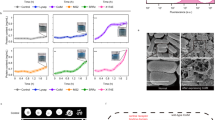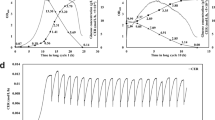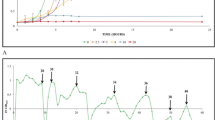Abstract
Industrial chemical production from renewable feedstocks by microbial cell factories provides a promising avenue towards sustainability. However, the small size of bacterial cells and environmental stress significantly affect microbial cell factory performance. Here, we engineered the Escherichia coli lifespan to improve the chemical production of poly(lactate-co-3-hydroxybutyrate) and butyrate. The replicative lifespan was shortened by deleting a carbon storage regulator, and the chronological lifespan was extended by deleting a response regulator and overexpressing sigma-38 in Escherichia coli. The replicative lifespan was fine-tuned using a two-output recombinase-based state machine, and the cell size was enlarged 13.4-fold. The highest poly(lactate-co-3-hydroxybutyrate) content of 52 wt% was achieved in a 5-l fermenter. The chronological lifespan was modulated through a multi-output recombinase-based state machine, resulting in the highest butyrate titre of 29.8 g l−1, by programming cell differentiation according to different fermentation stages. These results highlight the applicability of engineering the bacterial lifespan to increase microbial cell factory performance.
This is a preview of subscription content, access via your institution
Access options
Access Nature and 54 other Nature Portfolio journals
Get Nature+, our best-value online-access subscription
$29.99 / 30 days
cancel any time
Subscribe to this journal
Receive 12 digital issues and online access to articles
$119.00 per year
only $9.92 per issue
Buy this article
- Purchase on Springer Link
- Instant access to full article PDF
Prices may be subject to local taxes which are calculated during checkout






Similar content being viewed by others
Data availability
The data that support the figures within this paper and other findings of this study are available from the corresponding author upon reasonable request. Supplementary Table 9 provides a list of the GenBank accession numbers of the 14 key plasmids constructed in this study.
References
Nielsen, J. & Keasling, J. D. Engineering cellular metabolism. Cell 164, 1185–1197 (2016).
Wang, X., Zhang, H. & Quinn, P. J. Production of L-valine from metabolically engineered Corynebacterium glutamicum. Appl. Microbiol. Biotechnol. 102, 4319–4330 (2018).
Steensels, J. et al. Improving industrial yeast strains: exploiting natural and artificial diversity. FEMS Microbiol. Rev. 38, 947–995 (2014).
Park, J. H. & Lee, S. Y. Towards systems metabolic engineering of microorganisms for amino acid production. Curr. Opin. Biotechnol. 19, 454–460 (2008).
Chen, X. et al. DCEO biotechnology: tools to design, construct, evaluate, and optimize the metabolic pathway for biosynthesis of chemicals. Chem. Rev. 118, 4–72 (2017).
Kerfeld, C. A. Rewiring Escherichia coli for carbon-dioxide fixation. Nat. Biotechnol. 34, 1035–1036 (2016).
Luo, Y. Z., Enghiad, B. & Zhao, H. M. New tools for reconstruction and heterologous expression of natural product biosynthetic gene clusters. Nat. Prod. Rep. 33, 174–182 (2016).
Chen, X. et al. Metabolic engineering of Torulopsis glabrata for malate production. Metab. Eng. 19, 10–16 (2013).
Yu, T. et al. Reprogramming yeast metabolism from alcoholic fermentation to lipogenesis. Cell 174, 1–10 (2018).
Ksiazek, K. Bacterial aging: from mechanistic basis to evolutionary perspective. Cell. Mol. Life Sci. 67, 3131–3137 (2010).
Boehm, A. et al. Genetic manipulation of glycogen allocation affects replicative lifespan in E. coli. PLoS Genet. 12, 1–17 (2016).
Lindner, A. B., Madden, R., Demarez, A., Stewart, E. J. & Taddei, F. Asymmetric segregation of protein aggregates is associated with cellular aging and rejuvenation. Proc. Natl Acad. Sci. USA 105, 3076–3081 (2008).
Longo, V. D., Shadel, G. S., Kaeberlein, M. & Kennedy, B. Replicative and chronological aging in Saccharomyces cerevisiae. Cell Metab. 16, 18–31 (2012).
Kaeberlein, M. Lessons on longevity from budding yeast. Nature 464, 513–519 (2010).
Gonidakis, S., Finkel, S. E. & Longo, V. D. Genome-wide screen identifies Escherichia coli TCA-cycle-related mutants with extended chronological lifespan dependent on acetate metabolism and the hypoxia-inducible transcription factor ArcA. Aging Cell 9, 868–881 (2010).
Hill, S. M., Hao, X., Liu, B. & Nyström, T. Life-span extension by a metacaspase in the yeast Saccharomyces cerevisiae. Science 344, 1389–1392 (2014).
Fabrizio, P., Pozza, F., Pletcher, S. D., Gendron, C. M. & Longo, V. D. Regulation of longevity and stress resistance by Sch9 in yeast. Science 292, 288–290 (2001).
Orozco, H., Matallana, E. & Aranda, A. Two-carbon metabolites, polyphenols and vitamins influence yeast chronological life span in winemaking conditions. Microb. Cell Fact. 11, 1–10 (2012).
Finkel, S. E. Long-term survival during stationary phase: evolution and the GASP phenotype. Nat. Rev. Microbiol. 4, 113–120 (2006).
Piper, P. W., Harris, N. L. & MacLean, M. Preadaptation to efficient respiratory maintenance is essential both for maximal longevity and the retention of replicative potential in chronologically ageing yeast. Mech. Ageing Dev. 127, 733–740 (2006).
Arlia-Ciommo, A., Piano, A., Leonov, A., Svistkova, V. & Titorenko, V. I. Quasi-programmed aging of budding yeast: a trade-off between programmed processes of cell proliferation, differentiation, stress response, survival and death defines yeast lifespan. Cell Cycle 13, 3336–3349 (2014).
Wahl, A., Schuth, N., Pfeiffer, D., Nussberger, S. & Jendrossek, D. PHB granules are attached to the nucleoid via PhaM in Ralstonia eutropha. BMC Microbiol. 12, 1–11 (2012).
Farzadfard, F. & Lu, T. K. Emerging applications for DNA writers and molecular recorders. Science 361, 870–875 (2018).
Roquet, N., Soleimany, A. P., Ferris, A. C., Aaronson, S. & Lu, T. K. Synthetic recombinase-based state machines in living cells. Science 353, 1–13 (2016).
Nagy, A. Cre recombinase: the universal reagent for genome tailoring. Genesis 26, 99–109 (2000).
Grindley, N. D., Whiteson, K. L. & Rice, P. A. Mechanisms of site-specific recombination. Annu. Rev. Biochem. 75, 567–605 (2006).
Karzai, A. W., Roche, E. D. & Sauer, R. T. The SsrA–SmpB system for protein tagging, directed degradation and ribosome rescue. Nat. Struct. Biol. 7, 449–455 (2000).
Weinberg, B. H. et al. Large-scale design of robust genetic circuits with multiple inputs and outputs for mammalian cells. Nat. Biotechnol. 35, 453–462 (2017).
Gonidakis, S., Finkel, S. E. & Longo, V. D. E. coli hypoxia-inducible factor ArcA mediates lifespan extension in a lipoic acid synthase mutant by suppressing acetyl-CoA synthetase. Biol. Chem. 391, 1139–1147 (2010).
Fontaine, F., Stewart, E. J., Lindner, A. B. & Taddei, F. Mutations in two global regulators lower individual mortality in Escherichia coli. Mol. Microbiol. 67, 2–14 (2008).
Fredriksson, A. & Nystrom, T. Conditional and replicative senescence in Escherichia coli. Curr. Opin. Microbiol. 9, 612–618 (2006).
Gao, Y. et al. Charged residues in the H-NS linker drive DNA binding and gene silencing in single cells. Proc. Natl Acad. Sci. USA 114, 12560–12565 (2017).
Choi, S. Y. et al. One-step fermentative production of poly(lactate-co-glycolate) from carbohydrates in Escherichia coli. Nat. Biotechnol. 34, 1–6 (2016).
Maisonneuve, E., Ezraty, B. & Dukan, S. Protein aggregates: an aging factor involved in cell death. J. Bacteriol. 190, 6070–6075 (2008).
Pant, K. et al. Butyrate induces ROS-mediated apoptosis by modulating miR-22/SIRT-1 pathway in hepatic cancer cells. Redox Biol. 12, 340–349 (2017).
Yukihiro, F. et al. Commensal microbe-derived butyrate induces the differentiation of colonic regulatory T cells. Nature 504, 446–450 (2013).
Alvarez, H. & Steinbüchel, A. Triacylglycerols in prokaryotic microorganisms. Appl. Microbiol. Biotechnol. 60, 367–376 (2002).
Elena, G. F. et al. Bacterial inclusion bodies: making gold from waste. Trends Biotechnol. 30, 65–70 (2012).
Zhang, X. C. et al. Engineering cell wall synthesis mechanism for enhanced PHB accumulation in E. coli. Metab. Eng. 45, 32–42 (2017).
Jiang, X. R. & Chen, G. Q. Morphology engineering of bacteria for bio-production. Biotechnol. Adv. 34, 435–440 (2016).
Elhadi, D., Lv, L., Jiang, X. R., Wu, H. & Chen, G. Q. CRISPRi engineering E. coli for morphology diversification. Metab. Eng. 38, 358–369 (2016).
Galan, B. et al. Nucleoid-associated PhaF phasin drives intracellular location and segregation of polyhydroxyalkanoate granules in Pseudomonas putida KT2442. Mol. Microbiol. 79, 402–418 (2011).
Dorman, C. J. Horizontally acquired homologues of the nucleoid-associated protein H-NS: implications for gene regulation. Mol. Microbiol. 75, 264–267 (2010).
Jawed, K. et al. Engineered production of short chain fatty acid in Escherichia coli using fatty acid synthesis pathway. PLoS One 11, 1–20 (2016).
Saini, M., Wang, Z. W., Chiang, C. J. & Chao, Y. P. Metabolic engineering of Escherichia coli for production of butyric acid. J. Agric. Food Chem. 62, 4342–4348 (2014).
Luo, H. et al. Recent advances and strategies in process and strain engineering for the production of butyric acid by microbial fermentation. Bioresour. Technol. 253, 343–354 (2018).
Qi, Y., Liu, H., Chen, X. & Liu, L. Engineering microbial membranes to increase stress tolerance of industrial strains. Metab. Eng. 53, 24–34 (2019).
Dai, Z. J. & Nielsen, J. Advancing metabolic engineering through systems biology of industrial microorganisms. Curr. Opin. Biotechnol. 36, 8–15 (2015).
Wu, C., Huang, J. & Zhou, R. Progress in engineering acid stress resistance of lactic acid bacteria. Appl. Microbiol. Biotechnol. 98, 1055–1063 (2014).
Wu, H., Tuli, L., Bennett, G. N. & San, K. Y. Metabolic transistor strategy for controlling electron transfer chain activity in Escherichia coli. Metab. Eng. 28, 159–168 (2015).
Jung, Y. K., Kim, T. Y., Park, S. J. & Lee, S. Y. Metabolic engineering of Escherichia coli for the production of polylactic acid and its copolymers. Biotechnol. Bioeng. 105, 161–171 (2010).
Datsenko, K. A. & Wanner, B. L. One-step inactivation of chromosomal genes in Escherichia coli K-12 using PCR products. Proc. Natl Acad. Sci. USA 97, 6640–6645 (2000).
Gibson, D. G. et al. Enzymatic assembly of DNA molecules up to several hundred kilobases. Nat. Meth 6, 343–347 (2009).
Guo, L. et al. Enhancement of malate production through engineering of the periplasmic rTCA pathway in Escherichia coli. Biotechnol. Bioeng. 115, 1571–1580 (2018).
Li, Z. J. et al. Production of poly(3-hydroxybutyrate-co-4-hydroxybutyrate) from unrelated carbon sources by metabolically engineered Escherichia coli. Metab. Eng. 12, 352–359 (2010).
Young, J. W. et al. Measuring single-cell gene expression dynamics in bacteria using fluorescence time-lapse microscopy. Nat. Protoc. 7, 80–88 (2011).
Durante-Rodriguez, G., de Lorenzo, V. & Nikel, P. I. A post-translational metabolic switch enables complete decoupling of bacterial growth from biopolymer production in engineered Escherichia coli. ACS Synth. Biol. 7, 2686–2697 (2018).
Acknowledgements
This work was supported by the National Key R&D Program of China (2018YFA0901401), the National Natural Science Foundation of China (21808083, 21878126), the Key Field R & D Program of Guangdong Province (2019B020218001) and the National First-Class Discipline Program of Light Industry Technology and Engineering (LITE2018-08).
Author information
Authors and Affiliations
Contributions
L.G. and L.L. designed the project. L.G. and W.D. conducted and analysed the experiments. C.G., G.H., Q.D. and X.C. provided technical assistance. L.G. analysed the data and wrote the manuscript with input from C.Y., J.L. and L.L. All authors reviewed and approved the manuscript.
Corresponding author
Ethics declarations
Competing interests
The authors declare no competing interests.
Additional information
Publisher’s note Springer Nature remains neutral with regard to jurisdictional claims in published maps and institutional affiliations.
Supplementary information
Supplementary Information
Supplementary Figures 1–54, Tables 1–9, Notes 1–9 and references
Rights and permissions
About this article
Cite this article
Guo, L., Diao, W., Gao, C. et al. Engineering Escherichia coli lifespan for enhancing chemical production. Nat Catal 3, 307–318 (2020). https://doi.org/10.1038/s41929-019-0411-7
Received:
Accepted:
Published:
Issue Date:
DOI: https://doi.org/10.1038/s41929-019-0411-7
This article is cited by
-
Microbial cell factories based on filamentous bacteria, yeasts, and fungi
Microbial Cell Factories (2023)
-
Next generation synthetic memory via intercepting recombinase function
Nature Communications (2023)
-
A thermostable type I-B CRISPR-Cas system for orthogonal and multiplexed genetic engineering
Nature Communications (2023)
-
Microbial chassis design and engineering for production of amino acids used in food industry
Systems Microbiology and Biomanufacturing (2023)
-
Exogenous glucosylglycerol and proline extend the chronological lifespan of Rhodosporidium toruloides
International Microbiology (2023)



